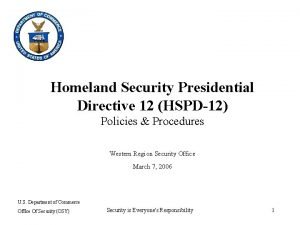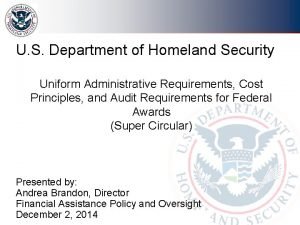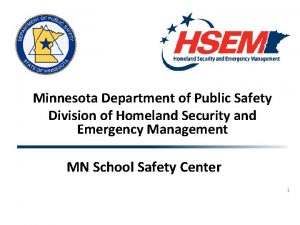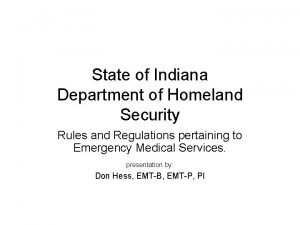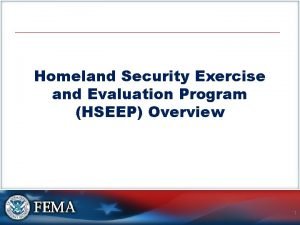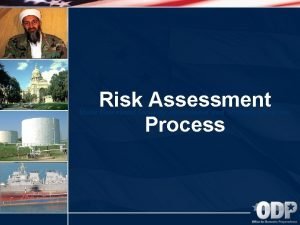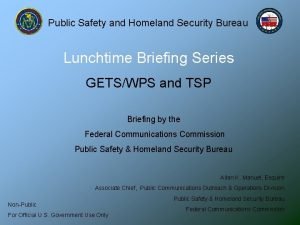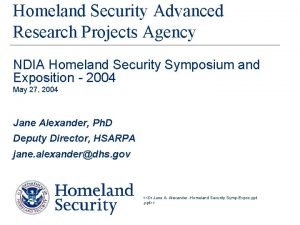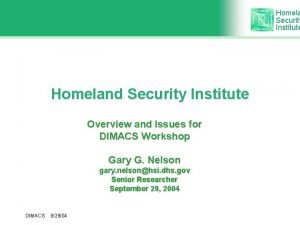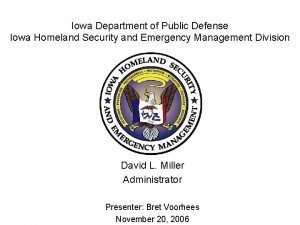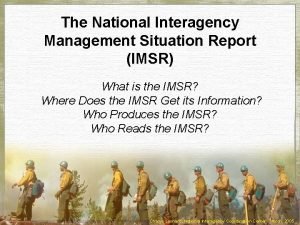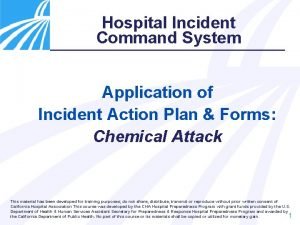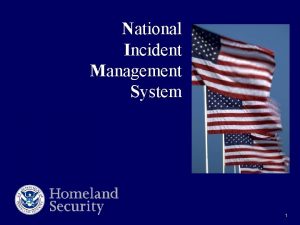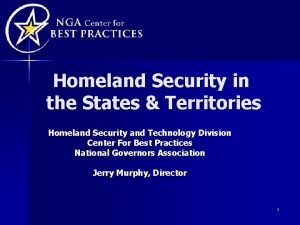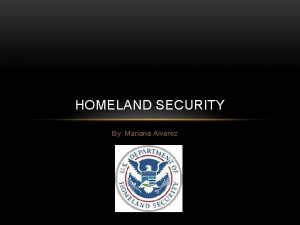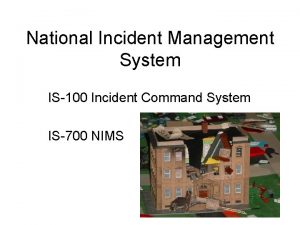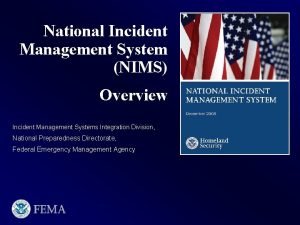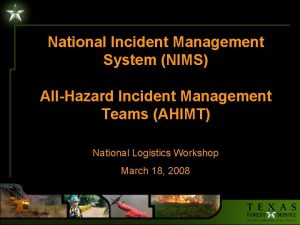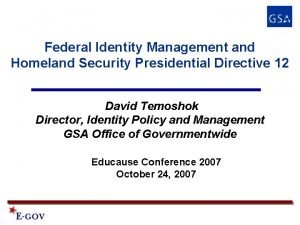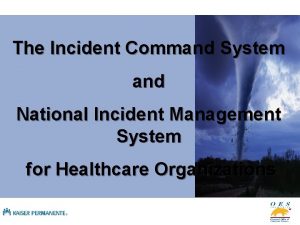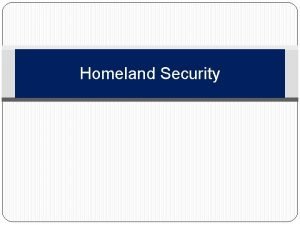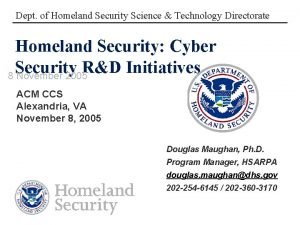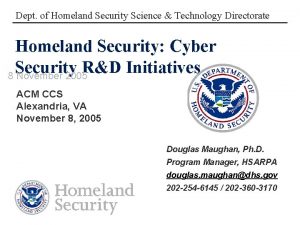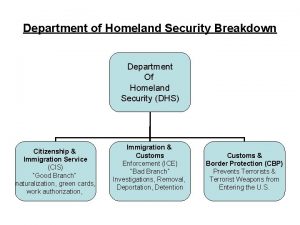The National Incident Management System Homeland Security Presidential



















- Slides: 19

The National Incident Management System

Homeland Security Presidential Directive 5 To prevent, prepare for, respond to, and recover from terrorist attacks, major disasters, and other emergencies, the United States Government shall establish a single, comprehensive approach to domestic incident management. The objective of the United States Government is to ensure that all levels of government across the Nation have the capability to work efficiently and effectively together, using a national approach to domestic incident management.

NIMS: What It Is / What It’s Not NIMS is… – Core set of • • • Doctrine Concepts Principles Terminology Organizational processes – Applicable to all hazards NIMS is not… – An operational incident management plan – A resource allocation plan – A terrorism / WMDspecific plan – Designed to address international events

Six NIMS Components 1. Command Management 2. Preparedness 3. Resource Management 4. Communications and Information Management 5. Supporting Technologies 6. Ongoing Management and Maintenance

1. Command Management • Standardizes incident management for all hazards and across all levels of government. • Based on three key constructs: • Incident Command System • Multiagency Coordination Systems • Public Information Systems

2. Preparedness • Specific measures and capabilities to enhance operational preparedness for incident management in an all-hazards context. – – – Planning Training & Exercises Personnel Qualifications and Certification Equipment Certification Mutual Aid Agreements Publications Management • Operational preparedness is not part of the NIMS.

What is the National Incident Management System, or NIMS? • A system that provides a consistent nationwide approach for incident management. • Requires Federal, State, tribal, and local governments to work together before, during, and after incidents. • Involves preparing for, preventing, responding to, and recovering from domestic incidents • All causes, sizes, and complexities of incidents.

4. Communications & Information Management • Common operating picture accessible across jurisdictions and functional agencies. – Allows incident managers at all levels to make effective, consistent decisions expeditiously – Ensures consistency at all levels of incident management. • Common communications and data standards to assure accessibility and interoperability.

5. Supporting Technologies • Provides an architecture for science and technology support to incident management: – – – Interoperability and compatibility Technology support Technology standards Broad-based requirements Strategic planning for research and development • Operational scientific support • Technical standards • Solving operational problems through research and development

6. Ongoing Management & Maintenance • NIMS Integration Center • All users and stakeholders participate in NIMS Integration Center activities – Various levels of government – Functional disciplines – Private entities • Process relies on – Lessons learned from actual incidents and exercises – Best practices across jurisdictions and functional disciplines

NIMS Timelines • NIMS became effective on March 1, 2004 • By October 1, 2004 NIMS Integration Center will publish standards, guidelines, and compliance protocols for determining whether a Federal, State, tribal, or local entity is compliant. • Other components require additional development and refinement to enable future compliance (e. g. , data and communications systems interoperability).

NIMS Compliance Requirements • Adoption is an eligibility requirement for Federal preparedness assistance to State & local governments. • Short term compliance for local, State, and Federal entities is possible by adopting the Incident Command System. • FY 2005 – State and local organizations must adopt NIMS to receive Federal preparedness assistance (through grants, contracts, and other activities).

Impact on Local Agencies • The National Wildfire Coordinating Group (NWCG) ICS training as a model for course curricula and materials applicable to NIMS: – ICS-100, Introduction to ICS – ICS-200, Basic ICS – ICS-300, Intermediate ICS – ICS-400 Advanced ICS • USFA’s National Fire Academy and Emergency Management Institute both follow this model in their ICS training curricula.

Impact on Local Agencies The Intelligence and Information function may be organized in one of the following ways: • • Officer within the Command Staff Unit within the Planning Section Branch within the Operations Section Separate General Staff section

Impact on Local Agencies • Personnel will be required to meet national qualification and certification standards to support an incident that transcends interstate jurisdictions. • State and local jurisdictions will be strongly encouraged to implement mutual aid agreements.

What is the National Response Plan? • A single, comprehensive approach to the management of Federal resources and coordination of Federal agencies in response to a disaster. • Consolidates: – the Federal Response Plan – the Terrorism Concept of Operations Plan – individual Federal agency response plans

The National Response Plan • Coordinates with State EOCs through the “National Emergency Operations Center. ” • Coordinates Federal response through the “Homeland Security Operations Center. ” • At incidents, Federal agencies will be coordinated through a “Joint Field Office” managed under the ICS concept: – Joint Operations Center – Joint Information Center – Other Federal agency on-site coordination centers

Structure for Federal NRP Operations Secretary, Department of Homeland Security Operations Center (HSOC) Governor State/Local Emergency Operations Centers Command & Control Coordination Regional Homeland Security Ops Ctr (RHSOC) Joint Field Office (JFO) Incident Command Post(s) (ICP)

Additional information on the NIMS and the NRP www. dhs. gov www. fema. gov www. usfa. fema. gov State emergency management agencies State fire training agencies Local emergency management agencies
 Homeland security presidential directive 12
Homeland security presidential directive 12 Homeland security infrastructure program
Homeland security infrastructure program Homeland circular
Homeland circular Department of homeland security minnesota
Department of homeland security minnesota Indiana department of homeland security ems
Indiana department of homeland security ems What is hseep
What is hseep Eku homeland security
Eku homeland security Homeland security vulnerability assessment
Homeland security vulnerability assessment Public safety and homeland security bureau
Public safety and homeland security bureau Homeland security advanced research projects agency
Homeland security advanced research projects agency Homeland security advanced research projects agency
Homeland security advanced research projects agency Homeland security acronym
Homeland security acronym Homeland security
Homeland security Nys department of homeland security
Nys department of homeland security Homeland security institute
Homeland security institute Iowa department of homeland security
Iowa department of homeland security Homeland security academy
Homeland security academy National interagency situation report
National interagency situation report Incident objectives that drive incident operations
Incident objectives that drive incident operations Private security
Private security
